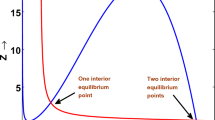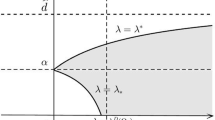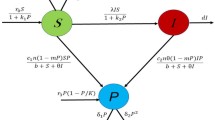Abstract
The problem of extinction of the prey population in a microbial predator-prey interaction in a chemostat has been examined. Usual deterministic lumped parameter models were used for the dynamics of the chemostat for large numbers of the two populations; the generalized birth and death stochastic process was employed for the description of the random variations at small prey numbers. Extinction probabilities of the prey population were calculated for different holding times and chemostat volumes, and their dependence upon the growth parameters of the two populations was studied. It was found that extinction was possible when the Monod model was used for the specific growth rate of the predators as a function of the prey number density. On the other hand, the decrease of the feeding activity of the predators at low prey densities predicted by the multiple saturation model acts as a regulatory factor that prevents extinction of the prey. In view of the fact that extinction of the prey has never been observed in the laboratory, the latter model seems more appropriate to describe the dynamics of microbial predation.
Similar content being viewed by others
Literature
Barnett, V. D. 1962. “The Monte Carlo Solution of a Competing Species Problem.”Biometrics,18, 76–103.
Bartlett, M. S. 1957. “On Theoretical Models for Competitive and Predatory Biological Systems.”Biometrika,44, 27–42.
—, J. C. Gower and P. H. Leslie. 1960. “A Comparison of Theoretical and Empirical Results for Some Stochastic Population Models.”Biometrika,47, 1–11.
Bharucha-Reid, A. T. 1960.Elements of the Theory of Markov Processes and Their Applications. New York: McGraw-Hill.
Bonomi, A. and A. G. Fredrickson. 1976. “Protozoan Feeding and Bacterial Wall Growth.”Biotech. Bioengng,18, 239–252.
Bungay, H. R. and M. L. Bungay. 1968. “Microbial Interactions in Continuous Culture.”Adv. Appl. Microbiol.,10, 269–290.
Canale, R. P. 1969. “Predator-Prey Relationships in a Model for the Activated Process.”Biotech. Bioengng,11, 887–907.
— 1970. “An Analysis of Models Describing Predator-Prey Interactions.”Biotech. Bioengng,12, 353–378.
—, T. D. Lustig, P. M. Kehrberger and J. E. Salo. 1973. “Experimental and Mathematical Modelling Studies of Protozoan Predation on Bacteria.”Biotech. Bioengng,15, 707–728.
Drake, J. F., J. L. Jost, A. G. Fredrickson and H. M. Tsuchiya. 1968. InBioregenerative Systems, Ed. J. F. Saunders, NASA Special Publication 165, pp. 87–94. Washington DC: U.S. Government Printing Office.
Feller, W. 1968.An Introduction to Probability Theory and Its Applications. New York: John Wiley.
Fredrickson, A. G. 1977. “Behavior of Mixed Cultures of Microorganisms.”A. Rev. Microbiol.,31, 63–87.
John, P. W. M. 1956. “Quadratic Time Homogeneous Birth and Death Processes.”Ann. Math. Statist. 27, 550.
Jost, J. L. 1972. “Dynamics of a Symbiotic System. Interactions in a Microbial Food Web.” Ph.D. Thesis. Univ. of Minnesota, Minneapolis.
—, J. F. Drake, A. G. Fredrickson and H. M. Tsuchiya. 1973a. “Microbial Food Chains and Food Webs.”J. Theor. Biol.,41, 461–484.
—. 1973b. “Interactions ofTetrahymena pyriformis, Escherichia coli, Azotobacter vinelandii and Glucose in a Minimal Medium.”J. Bacteriol.,113, 834–840.
Karlin, S. and J. L. McGregor. 1958. “Linear Growth, Birth and Death Processes.”J. Math. Mechs,1, 643–651.
Kendall, D. G. 1948. “On the Generalized Birth and Death Processes.”Ann. Math. Statist.,19, 1–15.
Leslie, P. H. 1958. “A Stochastic Model for Studying the Properties of Certain Biological Systems by Numerical Methods.”Biometrika,45, 16–31.
— and J. C. Gower. 1958. “The Properties of a Stochastic Model for Two Competing Species.”Biometrika,45, 316–330.
Lotka, A. J. 1924.Elements of Physical Biology. Baltimore, MD: William and Wilkins (reprinted NY: Dover, 1956).
Luckinbill, L. S. 1973. “Coexistence in Laboratory Populations ofParamecium aurelia and its PredatorDidinium nasutum.”Ecology,54, 1320–1327.
Mangel, M. and D. Ludwig. 1977. “Probability of Extinction in a Stochastic Competition.”SIAM J. Appl. Math.,33, 256–266.
Tsuchiya, H. M., J. F. Drake, J. L. Jost and A. G. Fredrickson. 1972. “Predator-Prey Interactions ofDictyostelium discoideum andEscherichia coli in Continuous Culture.”J. Bacteriol.,110, 1147–1153.
Volterra, V. 1926. “Variazioni e Fluttuazioni del Numers d'Individui in Specie Animali Conviventi.”Memorie Accad. Lineii Roma,2, 31–00 (1926).
Author information
Authors and Affiliations
Rights and permissions
About this article
Cite this article
Stephanopoulos, G., Fredrickson, A.G. Extinction probabilities in microbial predation: A birth and death approach. Bltn Mathcal Biology 43, 165–181 (1981). https://doi.org/10.1007/BF02459441
Received:
Revised:
Issue Date:
DOI: https://doi.org/10.1007/BF02459441




